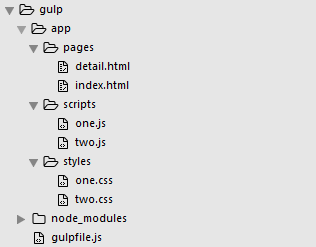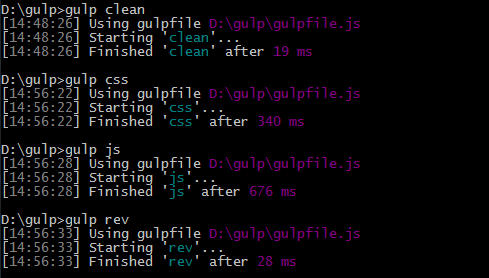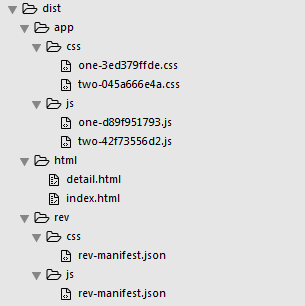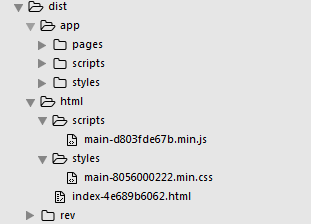Gulp:静态资源(css,js)版本控制
为了防止客户端的静态资源缓存,我们需要每次更新css或js的时候,通过md5或时间戳等方式重新命名静态资源;
然后涉及到的html模板里的src也要做相应的修改,静态资源需要优化(压缩合并)
然后涉及到的html模板里的src也要做相应的修改,静态资源需要优化(压缩合并)
文件目录结构

html模板文件
|
1
2
3
4
5
6
7
8
9
10
11
12
13
14
15
16
|
<html><head> <!-- build:css styles/main.min.css --> <link rel="stylesheet" href="../styles/one.css"> <link rel="stylesheet" href="../styles/two.css"> <!-- endbuild --></head><body> <!-- build:js scripts/main.min.js --> <script type="text/javascript" src="../scripts/one.js"></script> <script type="text/javascript" src="../scripts/two.js"></script> <!-- endbuild --></body></html> |
gulp配置文件:gulpfile.js
|
1
2
3
4
5
6
7
8
9
10
11
12
13
14
15
16
17
18
19
20
21
22
23
24
25
26
27
28
29
30
31
32
33
34
35
36
37
38
39
40
41
42
43
44
45
46
47
48
49
50
51
52
53
54
55
|
var gulp = require('gulp'), minifyCss = require('gulp-minify-css'), jshint = require('gulp-jshint'), uglify = require('gulp-uglify'), clean = require('gulp-clean'), rev = require('gulp-rev'), concat = require('gulp-concat'), revReplace = require('gulp-rev-replace'), useref = require('gulp-useref'), revReplace = require('gulp-rev-replace'), revCollector = require('gulp-rev-collector'); //清空文件夹,避免资源冗余gulp.task('clean',function(){ return gulp.src('dist',{read:false}).pipe(clean());});//css文件压缩,更改版本号,并通过rev.manifest将对应的版本号用json表示出来gulp.task('css',function(){ return gulp.src('app/styles/*.css') //.pipe( concat('wap.min.css') ) .pipe(minifyCss()) .pipe(rev()) .pipe(gulp.dest('dist/app/styles/')) .pipe(rev.manifest()) .pipe(gulp.dest('dist/rev/css'))});//js文件压缩,更改版本号,并通过rev.manifest将对应的版本号用json表示出gulp.task('js',function(){ return gulp.src('app/scripts/*.js') //.pipe( concat('wap.min.js') ) .pipe(jshint()) .pipe(uglify()) .pipe(rev()) .pipe(gulp.dest('dist/app/scripts/')) .pipe(rev.manifest()) .pipe(gulp.dest('dist/rev/js'))});//通过hash来精确定位到html模板中需要更改的部分,然后将修改成功的文件生成到指定目录gulp.task('rev',function(){ return gulp.src(['dist/rev/**/*.json','app/pages/*.html']) .pipe( revCollector() ) .pipe(gulp.dest('dist/app/pages/'));});//合并html页面内引用的静态资源文件gulp.task('html', function () { return gulp.src('dist/app/pages/*.html') .pipe(useref()) .pipe(rev()) .pipe(revReplace()) .pipe(gulp.dest('dist/html/'));}) |
task执行顺序

构建后的目录结构

构建后的html模板文件
|
1
2
3
4
5
6
7
8
9
10
11
12
13
14
15
16
|
<html><head> <!-- build:css styles/main.min.css --> <link rel="stylesheet" href="../styles/one-970d7f6a33.css"> <link rel="stylesheet" href="../styles/two-045a666e4a.css"> <!-- endbuild --></head><body> <!-- build:js scripts/main.min.js --> <script type="text/javascript" src="../scripts/one-d89f951793.js"></script> <script type="text/javascript" src="../scripts/two-42f73556d2.js"></script> <!-- endbuild --></body></html> |
如果需要对页面内引用的资源文件进行合并,这时我们可以利用:gulp-useref ,以及gulp-rev-replace 这两个构建工具的功能特性,然后执行gulp html 即可将index.html中引用的静态资源文件进行合并
执行gulp html之后的目录结构:

此时,构建后的html模板文件
|
1
2
3
4
5
6
7
8
9
|
<html><head> <link rel="stylesheet" href="styles/main-8056000222.min.css"></head><body> <script src="scripts/main-d803fde67b.min.js"></script></body></html> |